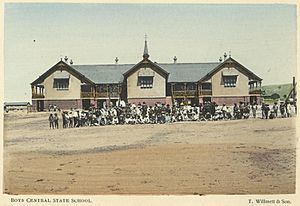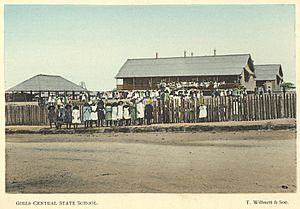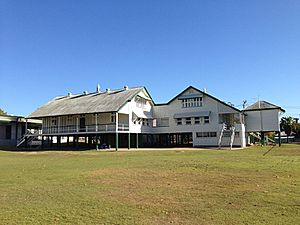Charters Towers Central State School facts for kids
Quick facts for kids Charters Towers Central State School |
|
|---|---|

Charters Towers Central State School, Infants' teaching building, 2014
|
|
| Location | 39-47 High Street, Charters Towers City, Charters Towers, Charters Towers Region, Queensland, Australia |
| Built | 1900 |
| Architect | Queensland Department of Public Works |
| Official name: Charters Towers Central State School; Charters Towers Girls' and Infants' Central State School; Charters Towers Boys' Central State School; Charters Towers Girls' Central State School; Charters Towers Girls' School; Charters Towers State High School | |
| Type | state heritage |
| Designated | 28 November 2014 |
| Reference no. | 602846 |
| Type | Education, research, scientific facility: School-state |
| Theme | Educating Queenslanders: Providing primary schooling |
| Builders | Benjamin Toll |
| Lua error in Module:Location_map at line 420: attempt to index field 'wikibase' (a nil value). | |
Charters Towers Central State School is a special school in Charters Towers City, Queensland, Australia. It is located at 39-47 High Street. The school was designed by the Queensland Department of Public Works and built in 1900 by Benjamin Toll. It is also known by its past names, like Charters Towers Girls' and Infants' Central State School. This school was added to the Queensland Heritage Register on 28 November 2014.
Contents
A Look at Charters Towers Central State School's Past
The Charters Towers Central State School has a long and interesting history. It first opened on its current site on 13 August 1883. Back then, it was called the Charters Towers State School for Girls and Infants. As the town grew, so did the school.
How the School Grew and Changed
In 1900, a new timber building was added. This building was for the infants' school. It faced Aland Street. Later, this building was used as a high school. It also served as a separate boys' school for a time. In 1965, the girls', infants', and boys' schools on the site joined together. They became what we know today as Charters Towers Central State School. The school has been open continuously since 1883 on this site. It has been a very important place for the local community.
Gold Rush and Early Schools
The Charters Towers area is the traditional land of the Gudjal people. European settlement began in 1871 when gold was found. The Charters Towers Goldfield was officially declared in 1872. Two towns started, Charters Towers and Millchester. Charters Towers quickly became the more important one. It became a municipality (a town with its own local government) in 1877. The discovery of the rich Day Dawn gold reef in 1878 brought even more wealth.
The first state school in the area opened in Millchester in 1874. Charters Towers Primary School opened on 18 October 1875. This first school was a few blocks away from the current Central State School site.
Education in Early Queensland
Providing public education was very important to the government in Queensland. National schools started in New South Wales in 1848. They continued in Queensland after it became a separate colony in 1859. By 1875, Queensland had 230 public schools. The State Education Act of 1875 made primary education free and compulsory. This helped most Queensland children learn to read and write by 1900.
Schools were seen as key to a community's success. Local people often helped by donating land or their time to build schools. Schools became a central part of the community. They were a symbol of progress and a source of pride.
Standard School Designs
The Queensland Government created standard plans for school buildings. This helped make sure schools were built consistently and affordably. From the 1860s to the 1960s, most Queensland school buildings were made of timber. This was an easy and cheap way to build schools, even in remote areas. These standard designs were always being improved. They focused on things like climate control, lighting, and fresh air.
The Girls' and Infants' School Site
The first Charters Towers Primary School became too crowded. A separate building for girls was added in 1879. But it still wasn't enough space. In 1880, it was decided that a completely separate school for girls was needed. A new site was chosen in 1881. This new site was east of High Street. It was next to the Roman Catholic Church School.
The new school site was on a hill called Mexican Ridge. It was described as "healthy... central and airy." It looked over the town. The government provided plans for a new building. After some delays, the new Girls' School opened on 13 August 1883. The old school site then became the State School for Boys.
The new building for the Girls' and Infants' School followed a standard design. It was created by architect Robert Ferguson.
Charters Towers Booms
Charters Towers continued to grow in the 1880s. It became Queensland's most productive goldfield. Getting gold from deep underground needed big machines. The arrival of the Great Northern railway line in 1882 also helped the town. It made supplies cheaper. By 1889, the famous Brilliant Reef, the richest gold reef, was found.
By 1884, Charters Towers had several schools. The State School for Girls and Infants had 421 students. In 1885, the Ferguson building was made bigger. An extra timber wing was added for infants' classes. By December 1885, the Girls' and Infants' School had an average of 690 students. In 1889, the girls' and infants' schools were separated, but they stayed in the same building.
Charters Towers kept growing even during tough economic times in the 1890s. In 1899, it produced a huge amount of gold. By then, it had about 26,500 people. It was the second most important city in Queensland.
In 1891, the school grounds for the girls' and infants' schools were made larger. By 1892, the Girls' School had 405 students. The Infants' School had 700 students. In 1895, the word "Central" was added to the names of the three state schools. This was to avoid confusion with other new schools.
The 1900 Infants' Teaching Building
As student numbers kept growing, a new, separate building was planned for the Infants' School. Benjamin Toll, a local builder, was chosen to build it in January 1900.
The 1900 Infants' teaching building was built to the east of the older Ferguson building. It was designed by the Queensland Department of Public Works. This department was in charge of school buildings until 2013. They were always trying new ideas to make school buildings better.
New Ideas in School Design
Between 1893 and 1914, school designs changed a lot. The main goal was to improve natural light and fresh air inside classrooms. They tried different ways to do this. This included special roof vents, ceiling vents, and larger windows. For timber buildings, a single layer of wood was often used for walls. This helped keep the building cool and saved money. Wide verandahs were also common. They shaded the building and offered extra teaching space.
A big change was building schools high off the ground. This started in the late 1890s. It allowed for better airflow and created covered play areas underneath. This became a common feature of Queensland schools. They also added special ventilation flaps near the floor. These could be opened to let more air in. Combined with ceiling vents and roof vents, this greatly improved air quality and kept rooms cooler.
Features of the New Infants' Building
The new infants' teaching building at Charters Towers Central State School faced Aland Street. It had many of these new lighting and ventilation features. It was an L-shaped building with two large classrooms. Each classroom had wide verandahs at the front and back. There were also smaller rooms for hats and cloaks, and a teachers' room.
The building was built high off the ground. This meant the whole area underneath could be used as a playground. This was an early example of a design that became standard later on. Toilets were also placed underneath the building. The classrooms were tall and had good light and air. They had tall windows with deep hoods, fanlights, and special ventilation flaps at floor level. There were also ceiling vents connected to roof vents.
When it opened, the new building was for infants (children aged 5 to 7). The spaces they used before in the Ferguson building became junior girls' classrooms. The new infants' building had 219 students when it opened.
Changes After the Gold Rush
By the time the Infants' School opened, Charters Towers was no longer a booming gold town. Gold production slowly went down after 1899. Most mines were closed by 1916. The last big mine closed in 1917. Many timber buildings were moved to Townsville. By 1921, Charters Towers' population had dropped a lot. Some large houses were turned into boarding schools. Charters Towers started to become a center for education in North Queensland.
The Infants' School's student numbers dropped in the early 1900s. This was due to outbreaks of illnesses like measles and influenza. In 1907, there were 191 infants. By 1911, this number was only 137. By 1912, the Infants' School was small enough to move back into the Ferguson building. The girls' and infants' schools were reunited.
High School and Boys' School
The empty infants' teaching building was then used by the new Charters Towers State High School. It opened on 22 January 1912. This was one of Queensland's first six high schools. Before this, the government didn't focus much on state secondary education. Sometimes, a primary school would add a "high top" to teach older students. This was a cheaper way to provide high school education using existing buildings.
Around 1917, the former infants' building was changed for high school use. The large classrooms were divided into two smaller ones. The hat and cloak room became a classroom. A Principal's Office was added.
The High School eventually became too crowded. In 1929, it swapped places with the Charters Towers Boys' Central State School. The Boys' School moved into the 1900 former infants' building. It remained separate from the Girls' and Infants' School.
Amalgamation and Modern School
In 1965, the boys', girls', and infants' schools all joined together. They were renamed Charters Towers Central State School. The 1970s saw a lot of growth for the school. New buildings were added, including a library and a dental clinic. More land was bought for a preschool and a play area. Today, the school grounds cover about 2.49 hectares (about 6 acres).
The school still uses the 1900 infants' teaching building today. It has been a vital part of Charters Towers since 1883. It has taught many generations of students. The school grounds and buildings have also been the location for many community events over the years.
What the School Looks Like Today
Charters Towers Central State School is located in Charters Towers. It covers a large area bounded by Mexican, High, Aland, and Boundary streets. The school has many different buildings. The former infants' teaching building from 1900 is in the northeast corner. It was built using an early design from the Department of Public Works. Today, the main entrance to the school is from High Street. However, old trees still mark the former main entrances on Aland Street.
The Former Infants' Teaching Building
The former infants' teaching building stands behind a small lawn. You can reach it from the Aland Street entrance. This building is made of timber and has weatherboard siding. It is built high off the ground on concrete stumps. It has two wings that form an L-shape. Each wing has gabled roofs and verandahs at the front and back.
There are also two small rooms that stick out from the verandahs. One was for hats and cloaks, and the other was a teachers' room. There is also a principal's room. The main roof is made of corrugated metal. It has metal vents on the ridges to help with airflow. The hat and cloak room and teachers' room have special packed weatherboards for ventilation. The gable walls also have louvred panels for air circulation.
The building has a balanced look. The original windows are timber-framed and pivot from the center. They have high sills. Later, some awning windows were added below these. The gable ends have wide window hoods. These hoods are made of timber and metal. The space under the building is used as a covered play area.
Timber stairs lead up to the verandahs. The verandahs have timber railings. Some parts have decorative lattice and battens. The ceilings on the verandahs are lined with beaded boards. The walls facing the verandahs have a single layer of timber. Original windows that pivot from the center are still there. French doors with fanlights lead into the classrooms. Other doors lead to the hat and cloak room, and the teachers' and principal's rooms.
Inside, the east and south wings are each divided into two classrooms. The classrooms have high, curved ceilings lined with beaded boards. They also have decorative timber vents in the center of the ceiling. At the bottom of the verandah walls, the lowest board can be opened to let in fresh air.
Other buildings on the school grounds are not considered part of the heritage listing.
Why This School is Special
Charters Towers Central State School was added to the Queensland Heritage Register in 2014. This means it is a very important historical site.
A Glimpse into Queensland's History
The former infants' teaching building (built in 1900) shows how state education and school architecture changed in Queensland. It is a great example of how buildings were designed based on the government's ideas about education. This building is an early and well-preserved example of a high-set school design. It also shows early experiments with ventilation.
The school is also important because it shows the growth of Charters Towers in the late 1800s. During this time, Charters Towers was very important for Queensland's economy because of its gold. The size of the school by 1900 reflects this importance.
Unique School Design Features
The former infants' teaching building shows how standard designs developed for Queensland state schools. It was built during a time when the Department of Public Works was trying out new ideas.
This building still has many features of a standard timber-framed school building from 1894 to 1914. This period focused on better natural light and fresh air. These features include:
- Being built high off the ground.
- Walls made of a single layer of timber.
- Wide verandahs on two sides of the tall classrooms.
- Lined interior walls.
- Tall windows with high sills and fanlights.
- Shading from lattice, battens, and wide window hoods.
- Many ways to get fresh air, like packed weatherboards, hinged flaps, ceiling vents connected to roof vents, and louvred panels in the roof.
Smart Building Innovations
The former infants' teaching building shows how clever the Department of Public Works was around 1900. They found creative ways to use natural light and ventilation. It was designed to handle a hot, dry climate. This building also has the earliest known example of special wall ventilation flaps at floor level.
A Strong Community Connection
Schools in Queensland have always been important to their communities. They often have strong and lasting connections with former students, parents, and teachers. They are places for social events and volunteer work. Schools are a source of pride and show a community's progress.
The Charters Towers Central State School's former infants' teaching building has a strong and ongoing link with the Charters Towers community. The school has been on its current site since 1883. It has educated many generations of children from Charters Towers.
|




